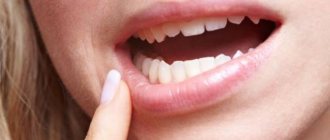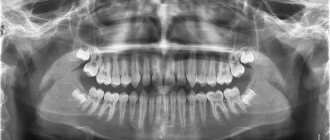Wisdom teeth are obviously called so because they erupt when a person has already accumulated some life experience - at 17 - 25 years old. By this time, the process of body formation usually ends, bone growth stops, joints begin to harden, and destructive reactions called aging are launched in cells. By the time wisdom teeth awaken, the jaws have also already become stronger and formed, so the eruption of third molars is often accompanied by headaches, general malaise, fever and inflammation in the lymph nodes and gums.
If a wisdom tooth grows horizontally into a tooth, then the patient consults a dentist. An experienced surgeon immediately understands what caused the anxiety and prescribes a series of examinations, with the help of which the picture of what is happening is assessed. The combination of painful sensations usually indicates the incorrect position of the eighth tooth, so it has to be removed. The dentist’s task is to study the results of research on the condition of the jaw and get rid of the problematic tooth with the least possible consequences for the patient.
What to do if a wisdom tooth grows horizontally - correct it or remove it?
The wisdom tooth (eight or third molar) is the farthest element in the row, which appears later than all the others, and in some cases remains in the gum. Its internal structure is distinguished by a complex, often branched and tangled root system. In addition, this is the most problematic tooth, since most often it is initially in the wrong position, grows in a horizontal direction and thereby creates a lot of inconvenience, and also provokes serious complications. Today we’ll talk about the causes and consequences of the horizontal position of the wisdom tooth, as well as what to do in such a difficult situation.
Causes of dystopia
REFERENCE Dystopia is an incorrect position in the dentition or movement beyond the edge of the alveolar process of the jaw.
During the intrauterine development of a child, data about the jaw model is laid down. First, the incisors, canines, premolars and other molars appear, and only then the eights erupt, which otherwise do not have enough space. The body directs tooth growth to where there is free space. This is the main reason for the horizontal position of the molar, but there are a number of others :
- Atavism, in which the erupting extra teeth occupy the free area of the gums intended for eights.
- Malocclusion due to jaw fracture.
- Eruption of permanent teeth in a chaotic manner due to the loss of baby teeth ahead of schedule.
- Lack of guidance for the eruption of wisdom teeth.
Why do eights almost always grow incorrectly?
The rudiments of wisdom teeth form in all people, but they do not always erupt completely, and may not appear above the gum at all. They begin to grow last, at about 25 years of age. The problem is that eights are rudiments that we inherited from our ancestors. In ancient times, when people had to eat raw meat, their jaw system was much larger, and the wisdom teeth in it performed the function of thoroughly crushing solid food.
Evolution has greatly changed our appearance, and the jaw arches have noticeably decreased in size over time. Therefore, there is simply not enough space left for the eights, and this is one of the main reasons why in most cases they lie horizontally and grow in the wrong position. As a result, excessive pressure is exerted on neighboring elements, which leads to deformation of the entire row.
Third molars grow very slowly and often remain half under the gum - this phenomenon is called retention. When an impacted wisdom tooth is also in a horizontal position, experts diagnose it as dystopia. All this usually leads to the development of inflammatory processes in the mucous membrane and rapid destruction of dental tissues by caries.
Why don’t everyone develop eights?
No, not because someone is wise and someone is not so wise. Let's start with the fact that the absence of third molar rudiments from birth is very rare. But not everyone has them. There may be several reasons for this:
- Design features of the jaw . Due to the fact that eights begin to climb at a time when the dentition is already fully completed, they simply have nowhere to squeeze in.
- Genetic predisposition . There is a theory that if you have painful teething or removal of eights in your family, they may not grow.
| According to statistics, 92% of people have all four eights. Of these, in 25% they do not erupt. 8% of humanity does not have third molars even in their embryonic state. And 0.1% of the adult population has a superset - more than four “wise” teeth. |
How to determine that a wisdom tooth is “lying on its side” - symptoms
Dental experts identify several sure signs that the figure eight is growing horizontally. Here are the main symptoms:
- constant aching pain in the specified area,
- development of inflammatory processes, often with the release of pus,
- a feeling of discomfort when opening the mouth and chewing food,
- heavy bleeding
- row curvature,
- temperature increase,
- the formation of a gingival hood in the place where the tooth should appear.
If the tooth grows incorrectly, inflammation and gum hood may form.
If the above symptoms appear, you should immediately consult a dentist. The sooner you visit a doctor, the lower your risk of complications.
Symptoms of dystopia of the 3rd molar
It is impossible to visually or tactilely determine the position of the growing figure eight. Among the symptoms indicating abnormal growth of this dental unit are:
- inflammation of gum tissue;
- the appearance of a “hood” of soft tissues;
- dull pain in the jaw;
- painful pressure on the root of an adjacent tooth;
- acute pain in the area of the second molar;
- enlargement of the submandibular lymph nodes;
- inflammation of the trigeminal nerve (pain in the jaw, back of the head, ear).
It is important not to try to diagnose yourself, but to go straight to the doctor. Among the methods for diagnosing this anomaly, the most effective are:
- radiography - an x-ray of the affected area;
- orthopantomogram - panoramic x-ray of the jaw;
- cone beam tomogram - used in severe cases.
Diagnostics using special medical equipment allows you to most accurately determine the position of the dental unit, the condition of the roots and bone tissue. Based on the diagnostic results obtained, the dentist makes a decision on methods of treatment or extraction of the problem tooth.
If you do not remove the dystopic figure eight, there is a danger of complications
If the third molar grows at an angle, it poses a threat to the health of other teeth, so this situation requires timely medical intervention. It also creates a constant traumatic effect on the mucous membrane, which can soon provoke inflammation. If you continue to ignore the symptoms, it can lead to even more serious problems:
- purulent lesions - an open wound appears at the site of eruption, and if pathogenic microorganisms get into it, this can lead to inflammation and purulent processes. As a result, there will be a risk of developing periodontitis, abscesses and even osteomyelitis,
- bleeding - if the tooth lies deep enough and horizontally, then during its growth the vessels will be injured, which can easily provoke serious bleeding,
- curvature of the bite - figure eights displace their “neighbors”, which soon leads to deformation of the occlusion as a whole,
- There are numerous abrasions and scratches on the mucous membrane - the result of constant injury to soft tissues and a direct prerequisite for infection.
Horizontal tooth growth brings many complications.
One of the most severe complications is the development of oncology. This happens very rarely, but experts still do not exclude the possibility of this sad scenario developing. The risk in this case is due to the constant traumatic effect on the cheek from the inside, which in the future can lead to dangerous structural changes in the mucosa and the appearance of malignant neoplasms.
Why is dystopia dangerous?
Failure to see a dentist in a timely manner can lead to complications such as:
- A wisdom tooth that fits tightly to the wall of a healthy neighboring tooth will destroy its enamel and a carious cavity will form.
- A horizontally growing figure eight will harm the entire dentition and cause crowding and malocclusion.
- The sharp edge of the crown will damage the mucous membrane and begin to cause persistent pain. The area will become inflamed and a wound will open, which can become infected.
- The soft tissues of the face, cheeks and gums gradually fester. There is a high probability of trigeminal neuralgia, periodontitis, cysts and fistulas, and if left untreated, phlegmon can spread.
- Chewing and opening your mouth will become difficult due to pain.
- In some cases, body temperature rises.
- A deep-lying figure eight touches nearby vessels. Due to their damage, constant bleeding occurs.
- Malignant and benign tumors will appear due to the pressure of the molar on the cheek and the degeneration of the affected areas.
What to do if your wisdom tooth grows to the side
If the figure eight grows in a horizontal direction and rests on another tooth, the only solution to this problem is to remove the causative element. As a rule, it is possible to diagnose dystopia at the very first stages of eruption. In such cases, prophylactic extraction is carried out even before the tooth fully appears and provokes a number of serious complications.
We are talking about complex removal, for which more powerful anesthesia and special instruments are used. So, if the figure eight on the lower jaw is to be removed, experts give preference to conduction anesthesia, which completely blocks the inferior alveolar nerve. Almost always you have to cut the mucous membrane and apply sutures after all manipulations. In some cases, the doctor is forced to separate the roots or saw the crown in order to extract the tooth in parts. The decision on how best to remove the impacted and dystopic figure eight is made by the attending surgeon.
Before removal, the patient must undergo an x-ray examination
Before the procedure, the patient must undergo an X-ray examination. The image allows the doctor to accurately determine the number and shape of the roots, their depth, and the possible presence of pathological foci in the root area.
How is the operation performed and how long does it take?
It all starts with an examination and x-ray. The doctor must know how the molar is located and what kind of root system it has. The removal tactics depend on the data received.
Simple extraction
Removing a third molar does not always require complex manipulations. If the crown is well preserved and there are no complications, a simple operation is performed using ordinary forceps. Procedure steps:
- Local anesthesia.
- Antiseptic treatment.
- Application of forceps and their fixation.
- Rocking, dislocation and extraction of the molar from the socket.
- Removing fragments if a tooth is crumbled.
- Treatment of the wound.
Simple extraction lasts from 5 to 15 minutes.
Complex extraction
If the number eight is dystopic, retinal, or all at once, then you won’t be able to get rid of it quickly and easily. To remove the problematic figure eight, the doctor can use a scalpel, drill, laser, elevator and other surgical instruments. Operation stages:
- Local or general anesthesia.
- Antiseptic treatment.
- Dissection of the gum, spreading its edges and exposing the tooth.
- If necessary, drilling or cutting off bone tissue, dividing the tooth root into several parts.
- Complete or partial extraction of a dental unit.
- Stop bleeding.
- Treatment of the wound with antibacterial and anti-inflammatory medications.
- Stitching of soft tissues.
The duration of complex extraction is from 30 minutes to 2 hours. If non-absorbable threads were used to stitch the gums, after 7-10 days you need to contact the clinic to remove them.
| It is easier to remove a wisdom tooth from the upper jaw than from the lower jaw. This is because the root of the upper molars is smooth and small, while the roots of the lower molars are complex and tangled. Plus, the lower jaw is denser and more massive than the upper jaw. |
How is removal carried out - description of the process
To remove an impacted figure eight, if it does not grow vertically, a full-fledged operation is required. Wisdom teeth have a complex, branched root system, which makes their extraction even more difficult. All this leads to the need to cut the gum and remove the element in parts.
Before the procedure, the patient is given conductive anesthesia, which completely “turns off” sensitivity in the working area. If the patient experiences an overwhelming fear of treatment, additional sedation can be performed with the introduction of a combination of powerful sedatives that completely relieve anxiety and anxiety. In some cases, including when it is impossible to use local anesthesia, the operation is performed under general anesthesia.
Removing such a tooth is a full-fledged operation
“I wanted to remove two figure eights at once under anesthesia, on the lower jaw. I didn’t want to stretch it out twice because of my heavy workload. But the dentist insisted on removal under local anesthesia, and at different times. He convinced me that the pain would still be the same, and there would be less stress on the body. Everything went more than great. I’m very glad that I didn’t go under anesthesia. Now with modern anesthesia there is nothing to be afraid of..."
Inga_Karpova, from correspondence on the woman.ru forum
To begin, the doctor makes a small incision in the gum and opens access to the bone structures. Then, using special tools, he either extracts the entire tooth, or first separates the roots or saws the crown, after which he removes the organ in parts. If there are no associated pathological phenomena, the procedure takes about 15-20 minutes. Upon completion of all manipulations, the doctor sutures the gum and treats the tissue with an antiseptic. For self-care, the patient is prescribed antiseptic oral baths, antibiotics, painkillers and anti-inflammatory drugs.
How to prepare for the procedure?
Proper preparation includes following a few simple guidelines:
- Do not drink alcoholic beverages 1-2 days before surgery.
- 1-2 days before the intervention, stop taking medications that reduce blood clotting (Aspirin, Ibuprofen, Heparin, etc.).
- On the eve of the operation, do not visit the bathhouse, sauna or solarium.
- One hour before the procedure, eat well.
- Perform all necessary oral hygiene procedures before visiting the clinic.
| To prevent chapped lips, use clear chapstick or Vaseline before visiting the dentist. |
Useful recommendations for the postoperative period
During the process of tooth extraction, surrounding tissues are inevitably injured. In addition, the vacated hole represents an open wound. Therefore, it is so important to strictly follow the doctor’s instructions during the rehabilitation period, as well as monitor oral hygiene and the integrity of the blood clot formed in the socket. Otherwise, the risk of complications and alveolitis in particular will increase significantly.
If you ignore the doctor's recommendations, alveolitis may occur.
As a rule, experts provide the following recommendations for the rehabilitation period:
- refuse to eat in the first 2-3 hours after the procedure,
- do not touch the hole with your tongue or fingers,
- avoid intensive rinsing and anything that can create a vacuum effect in the mouth - to use antiseptic solutions, it is better to use oral baths,
- temporarily avoid visiting saunas and steam baths, hot baths and intense physical activity,
- take antibiotics, painkillers and other medications strictly as prescribed by the doctor,
- if the area where the tooth used to be hurts too much, swelling has increased and bad breath has appeared, as well as if a blood clot is damaged - in all these cases you need to urgently consult a dentist.
To somewhat reduce the intensity of pain after the procedure, the specialist will prescribe anti-inflammatory and painkillers, for example, Nimesil, Nise or Nimesulide. These medications are often prescribed after oral surgery. In addition, medications based on the active substance nimesulide have a moderate antipyretic effect, so they also help reduce temperature in the postoperative period1.
After the operation, the specialist prescribes anti-inflammatory and painkillers
Regarding whether it is necessary to remove a wisdom tooth, there is no clear opinion on this matter. In fact, these rudiments no longer carry any important functional load. On the other hand, if the upper or lower 8 grows vertically, and does not in any way affect the position of its “neighbors,” it is not at all necessary to remove it. In any case, the decision remains with the attending physician and is always based on the individual characteristics of the clinical picture.
- Bezrukov V.M., Sukachev V.A. Complications after tooth extraction, 2000.
Are there any contraindications?
There are a number of contraindications to surgical procedures:
- infectious diseases in the acute phase;
- inflammatory oral pathologies;
- diseases of the cardiovascular system (heart failure, hypertensive crisis, recent heart attack or stroke);
- unsatisfactory health of the patient;
- state of alcoholic intoxication;
- mental disorders.
It is not advisable to have wisdom teeth removed during pregnancy. Surgical intervention during this period can negatively affect the development of the fetus and the woman’s health. Breastfeeding women have nothing to fear; surgery during breastfeeding does not carry any risks.
How long will your gums hurt and what can you do to relieve the pain?
Soreness is a normal physiological response to surgery. Third molars are large teeth with 2 to 5 roots. Therefore, you should not hope that the pain after their removal will go away in a few hours. Normally, the pain goes away after 3-7 days, but for complete healing of the wound it takes 2-3 weeks.
There is no need to endure pain for weeks. Drugs such as:
- Paracetamol;
- Analgin;
- Ibuprofen;
- Nurofen;
- Ketanov;
- Nimesil.
| To avoid pain altogether, you can take the pill before the anesthesia wears off. |










